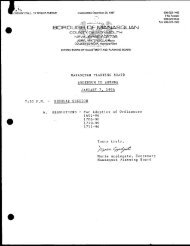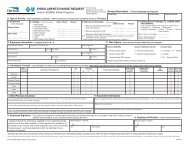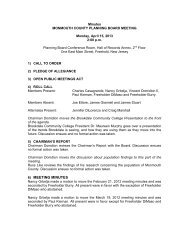NATURAL and CULTURAL FEATURES of MONMOUTH COUNTY
NATURAL and CULTURAL FEATURES of MONMOUTH COUNTY
NATURAL and CULTURAL FEATURES of MONMOUTH COUNTY
You also want an ePaper? Increase the reach of your titles
YUMPU automatically turns print PDFs into web optimized ePapers that Google loves.
had come to the earth since 1993, <strong>and</strong> which would not occur again until 2016. The moon was<br />
just 118 miles farther away than the nearest perigee measured during a 375-year period from<br />
1750 through 2125 (221,441 miles on Jan. 4, 1912) (Roylance, 2008). Since this occurred a few<br />
hours after 3-4” <strong>of</strong> rain fell during northeast winds, the morning high tide was about 2’ higher<br />
than either <strong>of</strong> the flanking high tides, reaching all the way to the dunes, brimming wetl<strong>and</strong>s <strong>and</strong><br />
flooding low lying coastal streets in the Bayshore <strong>and</strong> along the coast. Luckily, the northeast<br />
winds did not last for more than 24 hours; when that does happen, the onshore winds cause a<br />
“stacking <strong>of</strong> the tides” in the Shrewsbury River by slowing the ebb discharge, so that the next<br />
high tide accumulates on the previous one (MBEC, 1976). The next Perigean Spring Tide will<br />
occur on 7/21/09. NASA’s Phases <strong>of</strong> the Moon, which lists various aspects <strong>of</strong> the moon<br />
including perigees is at http://eclipse.gsfc.nasa.gov/TYPE/moonphase.html , <strong>and</strong> a “Lunar<br />
Perigee <strong>and</strong> Apogee Calculator” is located at http://www.fourmilab.ch/earthview/pacalc.html .<br />
Stevens Institute <strong>of</strong> Technology tracks tidal surges at S<strong>and</strong>y Hook at<br />
http://hudson.dl.stevens-tech.edu/SSWS/index.php?did=N021 .<br />
Earthquakes<br />
The first recorded earthquake in New Jersey was a 5.2 magnitude quake in 1737, <strong>and</strong> there have<br />
been a number <strong>of</strong> imperceptible ones since (M1-M3); as recently as, 12/8/05, there was a 2.1 in<br />
Morris County (Asbury Park Press(b), 2005). In 1979 a noticeable quake (3.5) occurred near<br />
Monmouth County in Cheesquake; there had also been a 3.8 in 1927 in Asbury Park. They are<br />
predominantly caused by the Ramapo Fault, named after the mountains along the northwestern<br />
margin <strong>of</strong> the Newark Basin in NY <strong>and</strong> NJ, <strong>and</strong> Cameron’s Line, which runs southward from<br />
New Engl<strong>and</strong> through central NJ under the Coastal Plain. The Newark Basin sits between these 2<br />
fault lines. The Ramapo Fault was very active 200 million years ago <strong>and</strong> at 1 billion years is one<br />
<strong>of</strong> the oldest faults in the US. One <strong>of</strong> the reasons that the East Coast <strong>of</strong> the US is less active than<br />
the West Coast is because it is geologically older; the crust on the East Coast is also cooler <strong>and</strong><br />
more rigid than on the West Coast, so seismic waves disperse further (Graver <strong>and</strong> Rubin, 1995;<br />
Jacob, 1995; Pasfield, 2005).<br />
Cameron’s Line is an 80 to 180 foot wide b<strong>and</strong> <strong>of</strong> crushed rock that lies about 600’ below NY<br />
Harbor (Waldman, 1999). It may be the remnants <strong>of</strong> a subduction zone that ceased during one <strong>of</strong><br />
the Appalachian uplifts during the Paleozoic Era, when the Taconic isl<strong>and</strong> arc collided <strong>and</strong><br />
attached to the continent (Graver <strong>and</strong> Rubin, 1995; Jacob, 1995; Pasfield, 2005). Four hundred<br />
<strong>and</strong> thirty million years ago, as the oceanic plate slid under the continental plate, a piece <strong>of</strong> the<br />
ocean crust broke <strong>of</strong>f <strong>and</strong> buckled against the continent, forming the green serpentine rock <strong>of</strong><br />
Todt Hill in central Staten Isl<strong>and</strong> (USGS, 2003). Serpentine deposits are markers for subduction<br />
zones, indicating that Cameron’s Line lies to the west <strong>of</strong> Todt Hill (USGS, 2003). At 410 feet,<br />
it is the highest natural point on the eastern seaboard south <strong>of</strong> Maine; Todt means ‘dead’ in<br />
Dutch, as the hill’s naturally-occurring, chrysotile asbestos soils were treeless, due to the<br />
abundance <strong>of</strong> magnesium (USGS, 2003). The New Jersey Geological Survey has a map <strong>of</strong><br />
“Earthquakes Epicentered in New Jersey” at http://njgeology.org/geodata/dgs04-1.htm .<br />
(Actually, the highest hill on the eastern seaboard south <strong>of</strong> Maine is now the Fresh Kills L<strong>and</strong>fill<br />
on Staten Isl<strong>and</strong>, which had been designed to reach a maximum height <strong>of</strong> 450 feet when it was<br />
closed in March <strong>of</strong> 2001, reopened on 9/13/01 after the attacks on the World Trade Center, <strong>and</strong><br />
finally closed in 2003 (Americas Ro<strong>of</strong>, 2006; IEI, 2007)).<br />
Nuclear Power

















